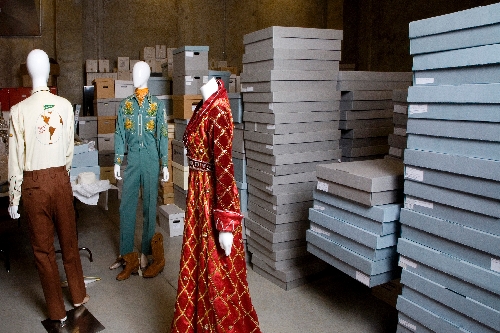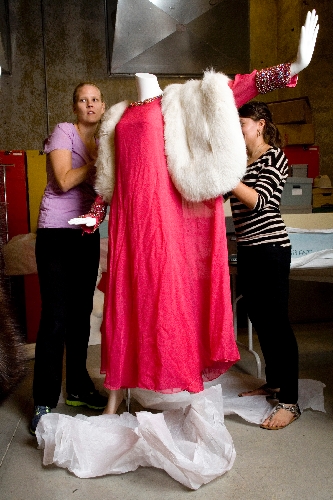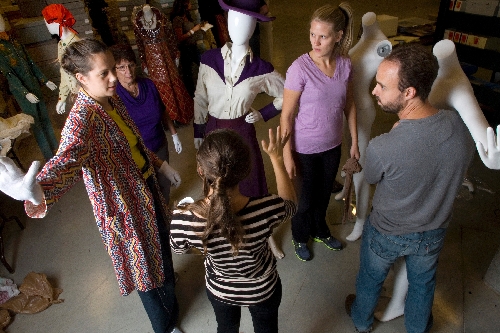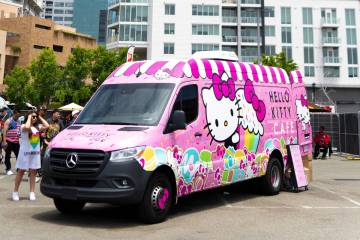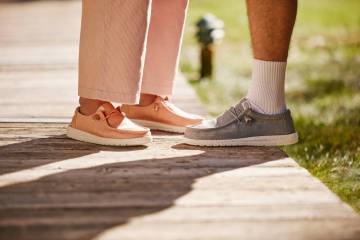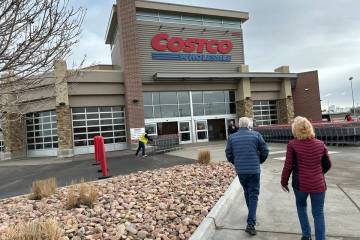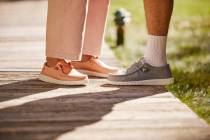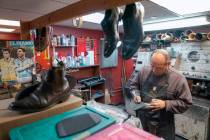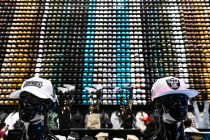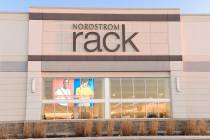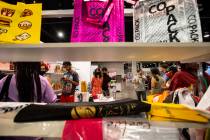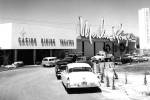UNLV history students study fashions on and off stage
For anyone who ever uttered the words, "They're just clothes," a class at the University of Nevada, Las Vegas has built a fine rebuttal. It has scoured famous closets, private collections and casino archives to find garments that hold within their threads the fabric of Las Vegas.
The rhinestone-studded cowboy garb from the Helldorado Days of the 1960s demonstrates a glamorization of the Wild West. The shimmer and flounce of his 1978 stage costume reflects the showmanship of Liberace and the city itself. The hot pink gown that draped Judy Bayley the night the Hacienda opened in 1956 represents Las Vegas not as a destination to see, but a prime place to be seen.
"Vegas Style: Spectacle and Spectator," an exhibit produced by UNLV history students under assistant professor Deirdre Clemente, debuts at the Nevada State Museum on Saturday and runs through June next year. It examines Las Vegas' rich history, from the family-friendly factor to the adult playground all the way to the economic downturn we face today. And, it's all told through fashion.
The clothes and costumes illustrate the stories. But the narrators are just as fascinating.
To have 10 graduate students both learning and teaching in a state museum is a rare, if not risky, way of doing things. Nevada State Museum director Dennis McBride, who calls the exhibit "an expression of a certain zeitgeist of our time," is relying on the old power in numbers logic.
This exhibit marks the first time the museum has collaborated with an outside group. Funding for cultural endeavors, like the museum, which is only open Friday through Monday, has taken a hard hit from the economy.
The hope is that the new mode of operation, combined with old modes of dress, will result in a fresh interest in Las Vegas history.
■ ■ ■
Out of respect for the garments they're handling, students sport white cotton gloves in a warehouse at the Nevada State Museum. They stand amid hundreds of $65 archival boxes that don't have staples, dyes, folds or anything else threatening the integrity of the costumes they contain.
The museum has yet to draw up exact figures, but it estimates the cost of mannequins, textile coverings, printing, lumber and other exhibit-related expenses to be a few thousand dollars. UNLV's history department contributed $1,000 and Clemente garnered some private donations, but the budget remains modest. And they still haven't raised the $5,000 necessary to hold a symposium.
With funds so tight, every decision counts.
On this Friday morning, the pressing matter on everyone's minds is which fur to drape over a 1960s evening gown, the mink or the sable? In a close vote, the sable wins.
Democracy solved that dilemma. Others require curator creativity.
Such as a slender mannequin that can't fully occupy the fringed dress of Liz Renay, the late burlesque dancer. Student Alex Clay Hutchings performs emergency breast enhancement using pillow stuffing and nylon stockings to fix that problem. Va va and voom.
There's also the issue of how to grow a 6-foot-2 mannequin to fit into the Ermenegildo Zegna suit made for a certain 6-foot-6-inch magician. Ta-da, chop it in half.
Today, students have learned that, much like the Helldorado Days that started in 1935, sometimes a little imagination can change everything.
Designed to lure tourists to town after the then-called Boulder Dam was built, Helldorado Days paid homage to Nevada's Wild West heritage. The folks who mounted broncos and tossed lassos in the festival's rodeo wore durable flannels and rugged denim, but the rest of the town polished the cowboy image until it shone like their beloved rhinestones.
How else to explain the glisten of the jade green Western shirt with white piping displayed in the "Vegas Style" exhibit? From the 1960s, former Lt. Gov. Rex Bell's Western store designed it, as the tag confirms. A painstaking, hand-embroidered desert landscape in shades of green and accents of orange starts on its pockets and sprawls across the back.
According to the students, it's probably safe to say the matching pants of that extravagant shirt never felt the rawhide of a saddle or the leather of a pair of chaps. But, in true Helldorado Days spirit, whoever wore them certainly felt pride of ownership. It didn't matter that the festival, which stopped production in 1998 but returned in 2005 for the city's centennial, represented a fantasy of Las Vegas' past. One in which fashion trumped function.
Helldorado Days remains one of the first and finest demonstrations of the entertained in Las Vegas becoming the entertainment, the theme of the "Vegas Style" exhibit. It goes to show the city's reputation as a stellar site for "people-watching" got started long before the term itself.
■ ■ ■
Some college classrooms feature things such as dry erase boards. This one has an Elvis parachute. From The Flying ELVI, it's an accessory to impersonator Jesse Garon's costume for the "Vegas Style" exhibit's King of Rock 'n' Roll era. It's also a fine way of keeping things interesting.
Students realize if it doesn't feature a buffet of silky feathers like the showgirl duds, or a Paris-made cloak like the original costume from "Tournament of Kings" at Excalibur, the average visitor might need a little visual encouragement to care about its history.
If all goes well, this exhibit should be something for audiences, not simply to hear or read, but to behold. Just the way Mr. Showmanship himself, Liberace, would want it.
The success the talented musician had with excess all began with fashion rebellion in the form of a simple white tuxedo. Performing with an orchestra at the Hollywood Bowl in 1952, Liberace shunned the traditional black tux in favor of something lighter, brighter. The crowd and media went wild at the sight of it.
The white tuxedo with a coat of tails would mark the first and last time he used subtlety to stand out.
Case in point, the centerpiece of the "Vegas Style" exhibit: Liberace's 7-foot Baldwin grand piano covered in tens of thousands of two-carat Swarovski crystals. The 1978 eggplant purple costume standing next to it boasts the same strobe light twinkle, but demonstrates one of his more modest getups. Even with a bow tied at the neck like gift wrapping, a bolero with sharp lapels and lace sleeves that flare with flair.
His Las Vegas run started in the 1940s at the Hotel Last Frontier, which hired him at $600 a week. The pianist's style of engaging the audience in a warm manner was such a hit, hotel officials doubled that figure within a week.
Liberace's swelling salary made possible his glut for all things gaudy.
In '55 he opened the Riviera at $50,000 a week. And, in the '70s he headlined the Las Vegas Hilton for $300,000 a week. When he returned to perform at Caesars Palace in the '80s, the hotel thanked him in the form of the world's largest rhinestone.
His style of interacting with his audience as he played pop and classical music endeared him to fans. At the end of his shows, he'd invite folks up to get a closer look at his piano and wardrobe. In any other town, such riches might have seemed a distant dream. With a casino just outside the showrooms, it was a slot pull away.
Between the dragging furs designed by Anna Nateece and outlandish costumes by Michael Travis, Liberace's look - to be emulated by Michael Douglas for an upcoming HBO film about his life - provided the ultimate "spectacle" for the Las Vegas "spectator."
■ ■ ■
When a student declares history as a major, parents don't always endorse the decision. Clemente knows because she fields the concerned calls from mom and dad, who just want to hear their kid will end up on the paying side of a Starbucks counter.
Her courses are designed to make careers in the field of history a feasible opportunity. That goes for all students, whether they're in their early 20s or one "old enough not to give my age," as Cynthia Cicero says.
She retired early from a county position with McCarran International Airport and decided she wanted to "go in a different direction." Cicero says she comes from a generation of women who didn't give a career much thought. Now she's thinking about it plenty and public history is foremost on her mind.
John Frey, 35, received an associate's degree in history in 2000, but became a union plumber shortly after. The $37 hourly wage lured him away from his studies. When the recession left him out of work, he went back to school.
"Now I can see a Ph.D. in my future," says the aspiring professor.
Cicero and Frey hope to finally make a career doing what they always wanted to do. It's a liberating feeling, one familiar to the spectators of Las Vegas, who come to this town and dress the way they want to dress.
"Las Vegas allows people to test the boundaries, to try something new and to sort of find out something new about themselves, and their own fashion, in an environment that nobody knows them," Clemente says.
While studying Las Vegas fashion over the years, her students made observations about the '60s looking so "nice" in sharp contrast to the dowdy tourists walking casinos today. Her job was to teach them to withhold judgment and focus on the "why?"
Here's what they found.
Credit the city's effort to become fun for the whole family for the sweats and flip-flops. Themed resort casinos of the early '90s, such as Excalibur, Luxor and New York-New York, gave way to a rise in comfort clothing.
With the boom of casino nightclubs such as Pure and Tao in the past decade, Las Vegas clearly reunited with the word "baby" and the exclamation point that follows. That explains, the students assert through the exhibit, the blend of risqué formal (a sequined minidress) with chic casual (designer distressed denim) so popular among today's casino night life.
But the "Spectator" portion of "Vegas Style" exemplifies the thinking that a walk through a casino is still the next best thing to a glide down a fashion runway. That was certainly the case when Judy Bayley donned a hot pink gown on the opening night of the Hacienda in 1956. Her husband, Warren "Doc" Bayley, was the original owner. When he died, Judy, much like her dress, took over.
The shade of pink won't settle for a glance. It wants a gaze. The sheer overlay, draping the slim sheath, lends elegance and fantasy. And the jewel-encrusted collar and cuffs remind folks of her status.
So, what happened between Judy Bayley's time and today?
"There's become a uniform that everybody dresses into. Who makes that uniform has changed," Clemente says. "It's not the rich people. It's the middle class. And they're the ones who started coming to Las Vegas."
■ ■ ■
Hutchings, 26, interned last summer and now works part time at the Las Vegas Convention and Visitors Authority's News Bureau, which has provided 60 photos for the exhibit.
His fellow students Frey and Christopher Sweet, 39, both have construction backgrounds. Frey built the frames for the News Bureau photo installations and Sweet spent more than four weeks hammering together the wooden platforms on which each mannequin stands.
Matt Mitchell, 29, works in the instructional technology department at the College of Southern Nevada. The techie is personally designing the free "Vegas Style" app that provides a tour with inside information, among other features.
And that's just the collaborative efforts of the class. Garments have been provided by the Nevada State Museum, the Junior League of Las Vegas, the Liberace Foundation, Shecky and Marie Green, the estate of Frank Sinatra, the Tropicana, the Burlesque Hall of Fame, Penn & Teller and many more. With the exception of the museum collection, it's all on loan. Everything is free of charge.
When the community comes together, an exhibit is made. When the races came together in 1955, history was made.
Las Vegas long had a reputation as the "Mississippi of the West" for good reason.
Sammy Davis Jr., Ella Fitzgerald, Louis Armstrong, Nat King Cole and Dorothy Dandridge could all bring a Strip audience to its feet. When the curtain came down, though, the legendary performers were asked to find other accommodations. They could headline on the Strip, but they couldn't sleep there. Segregation policies prohibited it.
When the first fully integrated casino hotel, the Moulin Rouge, opened in 1955, black showgirls found a stage. Black patrons found a place to be seen. And, black performers found an after-hours refuge.
The only problem? White performers did, too.
As exhibit text panels at "Vegas Style" tell it, the Strip casinos emptied out after midnight because everyone headed to the Moulin Rouge. That includes, when they weren't already performing there, Frank Sinatra and George Burns.
It operated for only six months, but the unity the casino hotel represented never lost its meaning.
Five years after it closed, civil rights activists used the site as a meeting place with city officials to demand integration on the Strip or face an organized march. Officials complied and the Strip abolished its segregation policies, a landmark moment for Las Vegas that started with the Moulin Rouge.
With the clock ticking behind them, students still haven't secured a garment to represent this section of the exhibit. They're counting on the estate of Sammy Davis Jr. to come through with a suit he wore during his time at the Moulin Rouge, but they haven't heard back in weeks.
Even though other options are available and only eight days remain before showtime, the students want to hold out for Sammy.
Their reasoning is that the iconic song and dance man may have linked his cuffs and buttoned his tailored suit jacket backstage at the New Frontier where he headlined. But for six months, he didn't loosen his tie until his shiny, patent leather tap shoes stepped into the Moulin Rouge.
■ ■ ■
Penn & Teller have a different kind of magic show. The big tip-off lies in their attire. Business suits don't exactly beg for bunny tricks, but they work well for exposing the deceit behind them.
The gray Ermenegildo Zegna pinstripe double-breasted suits the act donated to "Vegas Style" derive from 1985. That's before Zegna, the designer menswear brand whose made-to-measure suits can rival a BMW in cost, had two boutiques in town.
The Strip hadn't yet established itself alongside Fifth Avenue and Rodeo Drive as a luxury shopping destination. It's also long before the Rio provided a showroom for the now world-famous Penn & Teller.
The duo and the city they perform in have both come a long way since those fancy Italian suits were designed. But is Las Vegas now as debunked as the myths and tricks Penn & Teller expose through their show? It's just one of the many critical questions the students pose with "Vegas Style."
"Penn & Teller represent how Vegas is all an illusion," Hutchings says.
"Everything is all glamorous and glittery, but it's still very susceptible to changes in the economy, like the financial crisis."
The mannequins for Penn & Teller conclude the exhibit's storyline, contending that perhaps the casino doesn't always win.
Nevada State Museum director McBride remembers a time when the gaming industry and the community had a symbiotic relationship because casino owners lived here, shopped here and educated their children here. That was back in the '50s and '60s, the golden age of Las Vegas.
It might be long gone, but the era still has a strong presence in McBride's office, where he sits at a midcentury dinette set with soft-back chairs. Both furniture and community, he says, have diminished in quality since that time.
"I had hoped the economic crash and the evisceration it caused would teach the leaders in this town a lesson, not to put all their eggs in one basket," he says. "There has to be something more than all we lost, all we lost in gaming revenue."
When he ponders what an exhibit like this will look like in another 20 years, he finds a glimmer of hope.
The new digs of the Nevada State Museum at Springs Preserve, along with the openings of The Smith Center for the Performing Arts, the Neon Museum and the Mob Museum could really put a new face on the city.
And with a new face will come new clothes.
Contact Xazmin Garza at xgarza@reviewjournal.com or 702-383-0477. Follow her on Twitter @startswithanx.
PREVIEW
WHAT: "Vegas Style: Spectacle and Spectator"
WHEN: Opens Saturday, 10 a.m. to 6 p.m. Fridays-Mondays through June
WHERE: Nevada State Museum, 309 S. Valley View Blvd.
ADMISSION: $9.95 for locals; $18.95 for tourists (702-486-5205)



